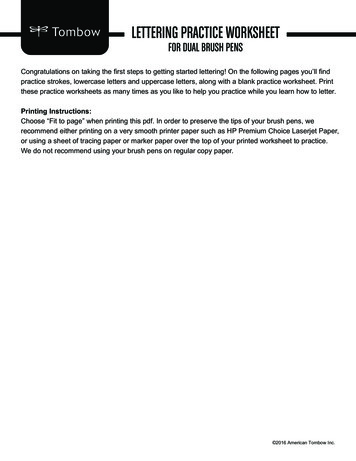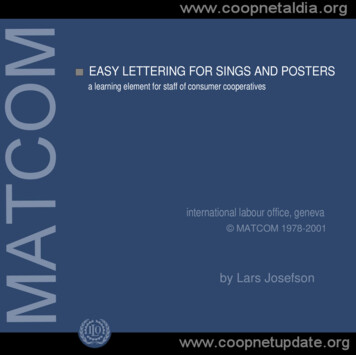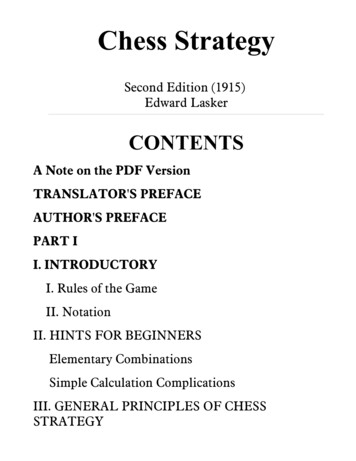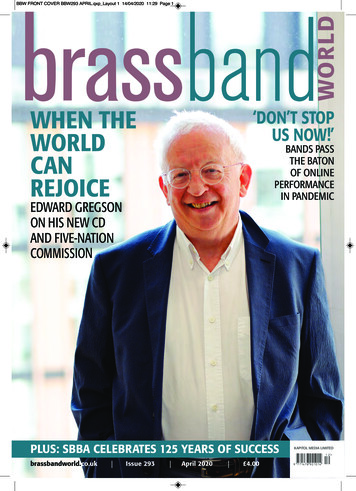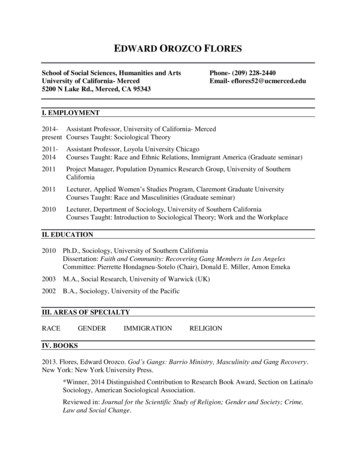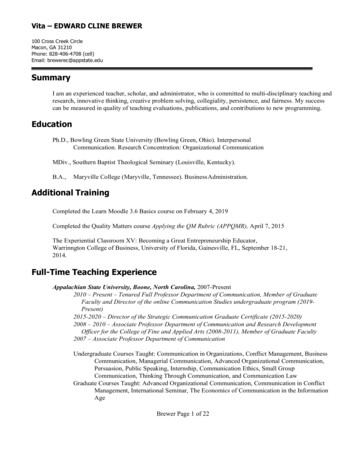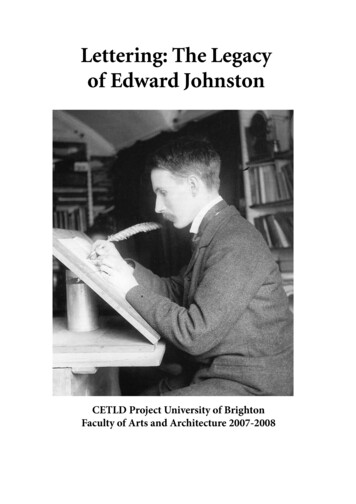
Transcription
Lettering: The Legacyof Edward JohnstonCETLD Project University of BrightonFaculty of Arts and Architecture 2007-2008
A A old Wolpe RDI (1905–1989) was a German-born typographer,typographic historian and type designer resident in London.He designed typefaces for Monotype and Bauer, the best known ofwhich is Albertus, based on the inscriptional letters he engravedwhilst working with Rudolf Koch. He also desgned over 1500 bookjackets for Faber & Faber. V&A held an exhibition of his work,“A Retrospective Survey” in 1980.a a aCETLD project : Lettering – Edward Johnston and his legacyFrom ‘26 Letters’ exhibition Brighton University 2008
C ON T E N T SThe Project4Background5Practical Workshops for Graphic Design students6Edward Johnston Foundation Archive7Educational Videos15Lectures17
The ProjectThis project is providing a consolidated learning space for HE design students by bringing together collections and material from partnership and other archival collections to advance the understanding ofEdward Johnston and his legacy in terms of his rediscovery of the fundamentals of formal handwritingand lettering and its continuing and widened relevance in the contemporary digital world (from electronic books to directional signage).In collaboration with the curator at the V&A and curatorial colleagues at the RIBA, and in the designarchives at Brighton, the project will examine the material located in all archives and in parallel includefresh exploration of the Edward Johnston Foundation’s archive in Ditchling with the aim of makingit accessible to students in Higher Education as well as other researchers and students both physicallyand on-line. Links to on-line materials located in other collections will be used to enhance the teachingmaterials and online effectiveness of the materials developed.A second strand will be the design of an educational programme for practice-based learning at Levels 2and Masters to explore the relevance of Johnston’s principles to contemporary letter design. The historical thread informing the development of letterform through the ages, forming the major element inJohnston’s teaching, has virtually disappeared in the educational environment and the importance ofre-establishing it is timely. Without the knowledge of this tradition further development in, for instance, the field of type design is stultified. These teaching materials will be tested by introducing themto students on the extension studies courses at Brighton, where they will automatically be drawn from awide range of disciplines.The project will be further enhanced and evaluated by outreach to a wider audience of learners andstudents through the medium of video podcasts, lectures, course materials, workshops and demonstrations and exhibitions.The benefit to students, especially those working with text will be to help them become better designersby providing them with a renewed understanding of the core value of the broad-edged pen as the primelettermaking tool and of its influence and continued relevance as far as contemporary letter design isconcerned. This concept was fully grasped by earlier generations of type designers, none more so thanHermann Zapf whose recent Zapfino Contextual Pro typeface stands at the cutting edge of digital fonttechnology, Contextual OpenType. Instead of the hitherto restricted palette of 256 individual characters within a font, the new technology offers up to 65,000 with the resultant potential for an unlimitedrange of stylistic and contextual variants. This is opening up profound possibities for designers able totake advantage of the material contained within the archive together with accompanying practice-basedteaching.Students will also benefit from the development of the EJF’s Wikipedia which will contain key authoritative articles on the subject of calligraphy and lettering to be submitted by selected experts in the field,supplemented by those already published in the Foundation’s Journal, catalogues and monographs.Connections will be made by hyperlink to other relevant material on the web and hopefully with wikisbeing developed within the CETLD partnerships. The EJF has digital expertise and its Wiki is alreadyfunctioning and will be fully operational by the end of the project.4
BackgroundThat modern calligraphy ever rose like a phoenix from the ashes of a forgotten craft was largely due to Edward Johnston. It is to his perception of fundamentals that formal penmanship owes its life and continuingtradition today. Heather ChildEdward Johnston (1872-1944) by his teaching and practice almost single-handedly revived the art offormal penmanship which had lain moribund for four centuries. His major work Writing and Illuminating, and Lettering, first published in 1906 and in print continuously ever since, created a new interestin calligraphy and a new school of excellent scribes. The life he breathed into this ancient craft and itscontinuing tradition even in today’s hi-tech world can be ascribed to his re-discovery of the influenceof tools, materials and methods. His researches were carried out with the understanding of the artistcraftsman, the scientist and the philosopher and this three-fold approach resulted in a profound insight- he fully grasped the root of formal writing and saw how all the branches grew from that root.The epoch-making sans-serif alphabet he designed for the London Underground Railways changed theface of typography in the twentieth century whilst two of the most popular types of our day ‘Perpetua’and ‘Gill Sans’ were by his great pupil Eric Gill (1882-1940).Johnston’s influence has been world-wide. As early as 1910 his pupil Anna Simons translated Writingand Illuminating, and Lettering into German and a tremendous interest was sparked off in that country.So much so that Sir William Rothenstein remarked on a visit to art schools on the continent, ‘in Germany in particular the name of Edward Johnston was known and honoured above that of any artist’.The other great revival has been in the United States particularly since the 1970s where there has beena veritable explosion of interest both on a professional and amateur level. The annual lettering conferences held in important centres throughout the country are testimony to this rebirth. But, lest we forgetJohnston’s pioneering work, we ought perhaps to remind ourselves of what Hermann Zapf has saidrecently of him,Nobody had such a lasting effect on the revival of contemporary writing as Edward Johnston. He paved theway for all lettering artists of the twentieth century and ultimately they owe their success to himThe Edward Johnston FoundationThe Edward Johnston Foundation is dedicated to the promotion of public awareness of calligraphy, notonly as an art form in its own right but also as the seed and reference point for many other letteringdisciplines including modern typeface design. Based in Ditchling, Sussex the birthplace of the modernrevival of calligraphy, the Foundation is working towards the establishment of a permanent centre forlearning, research and education in the lettering arts.5
Practical Workshops for Graphic Design studentsDuring the course of the project we ran three practical workshops under the above title for GraphicDesign and other students in the Arts and Architecture Faculty, University of Brighton. The aim of theworkshops was to introduce to students working in the field of graphic design, the velue of calligraphyin the design of letterforms. Hands on experience with the pen also provides a more direct involvementwith the arrangement of text and elements which improve readability and legibility such as letter, wordand interline spacing.Our view is that the phasing out of the craft of calligraphy in art schools in the 1960s (see Appendix4 for an article on the subject) was ill-judged and that there was a lack of appreciaition at the time ofthe status and value of the broad-edged pen as the prime letter-making tool. A grasp of the underlying principles of letter construction wihich the proper use of the pen provides is the key to a thoroughunderstanding of the design aspects of letterform and the stimulus for the development of new forms.The workshops were of short duration of three hours and were comprised of an illustrated lecture othelegacy of Edward Johnston and its continued relevance, followed by hands-on experience of workingwith the broad-edged pen. Blackboard demonstrations introduced students to the basic concepts of letter construction and how the letters of the alphabet related to one another in the interests of readabilityand legibility in text.They were very well attended and at least four tutors were able to participate, George Hardie, RobertGordon, Tom Sawyer and Lawrenec Zeegen. Feedback for all three workshops were in the form of aquestionnaire which included the following questions:1. D o you have any experience of calligraphy and/or typogarphy?2. Will you use what you have learned today in your future work?3. Are you interested in learning more about Edward Johnston? it?4. Do you want to improve your skills in calligraphy?Response to question 1 was Yes: 63%, No: 37%; question 2: Yes: 100%, No: 0%; question 3: Yes: 97%, No:3%; question 4: 91% No: 9%.For full details of questionnaire responses and comments see Appendix 56
Edward Johnston Foundation ArchivesThe project examined the material located in the archives of CETLD partners and in parallel includedfresh exploration of the Edward Johnston Foundation’s archive in Ditchling with the aim of making itaccessible to students in Higher Education as well as other researchers and students both physically andon-line. The intention was to establish links to on-line materials located in other collections to be usedto enhance the teaching materials and online effectiveness of the materials developed.In the examination of the EJF archive and in discussion with experts in the field it became apparent thatit would be necessary to bring it up to internatioanl standards in terms of cross-domain informationresource description. The most suitable method was identified as the Dublin Core metadata elementset but the enormity of the task meant that additional funding would need to be sought to implementthe work. At the time funding was available from JISC and NEH for a Transatlantic Digitisation Collaboration Grant. A US partner was identified, Notre Dame University, Indiana who hold an archive ofthe work of one of Johnston’s pupils Eric Gill.Proposed digital archive collaboration between Eric GillCollection, Notre Dame University USA and Edward Johnston Foundation, University of Brighton UKJISC/NEH Transatlantic Digitisation Collaboration Grant applicationFIRST STAGE SUMMARYContext: The Edward Johnston Foundation and Eric Gill collectionsAt the beginning of the twentieth century the calligrapher/typographer Edward Johnston revived theuse of the broad-edged pen for lettering design. He, together with his pupil Eric Gill, fundamentallychanged methods of modern letter design. This project aims to bring into the public domain a range ofarchival materials which: Offers primary and secondary sources for studying the impact of this revival; Explores the influence of Johnston and Gill on later typographers; Helps in understanding the underlying design principles of their approach to lettering design.This work is significant because most of Johnston’s teaching methods and strategies were undocumented and so have disappeared from both the research and teaching of calligraphy/typography. By structuring these archival materials and providing them digitally, the project aims to revive the knowledge ofJohnston, Gill and their followers, in the UK, US and internationally. This is of the up-most relevanceto arts and humanities, as such knowledge is very much at risk of being lost; yet, the re-discovery of thefundamentals of formal handwriting and lettering has a continuing and widened relevance to letteringdesign in the contemporary digital world. Without the knowledge of this tradition further developmentin the field of type design is stultified.7
Johnston’s and Gill’s influence has been worldwide. The three main centres of continuing study are theUK, USA and Japan. In the United States, since the 1970s, both professional and amateur interest isevidenced by the annual lettering conferences held in important centres throughout the country. Inthe UK, the Edward Johnston Foundation has been dedicated to the promotion of public awareness ofcalligraphy. The combining of parts of the Edward Johnston and Eric Gill collections into a pilot sharedarchive therefore aims to: Make key archival material publically available and easily accessible; Bring archival material alive and demonstrate the relevance of historical documents to contemporarypractices; Provide research and educational materials about Edward Johnston, Eric Gill and their followers; Provide evidence of sources, context and influence of this work in lettering design; Extend the knowledge of Johnston’s work/studies/teaching and his contemporaries: Lethaby, Gill,Morison, etc.; Demonstrate cross-influences between the UK and USA in type design historically, and the widerimpact internationally; Provide examples of contemporary practice – both paper-based and digital - influenced by these approaches; Offer lettering design students and practitioners significant sources to inform their own design work; Support the development of UK-US research collaborations in this area.Significance and ImpactMaking the Edward Johnston and Eric Gill collections available online therefore has an intellectualsignificance and impact for three main audiences: Arts and Humanities researchers working in design history, history of printing, late nineteenth andearly twentieth-century social history etc.; Educators and stu
way for all lettering artists of the twentieth century and ultimately they owe their success to him The Edward Johnston Foundation The Edward Johnston Foundation is dedicated to the promotion of public awareness of calligraphy, not only as an art form in its own right but also as the seed and reference point for many other lettering
